Long Term Monitoring (2014–2018) of Multi-Mycotoxins in South African Commercial Maize and Wheat with a Locally Developed and Validated LC-MS/MS Method
Abstract
:1. Introduction
2. Results
2.1. Mycotoxins in SA Commercially Produced Wheat
2.2. Mycotoxins in SA Commercially Produced Maize
2.2.1. Mycotoxins Found and Not Found
2.2.2. Deoxynivalenol and 15-acetyl-deoxynivalenol Occurrence
2.2.3. Fumonisin Occurrence
2.2.4. Zearalenone Occurrence
3. Discussion
3.1. Wheat
3.2. Maize
3.2.1. Mycotoxins Not Found
3.2.2. Effect of Maize Class, Production Year and Production Province
3.3. Regulated Mycotoxins and Maximum Allowable Levels
4. Conclusions
- the presence of only deoxynivalenol (at low concentrations) in SA wheat;
- the absence of aflatoxin B1 in maize produced commercially in SA in all the regions;
- the concentrations, regional variation and seasonal trends of deoxynivalenol, fumonisins and zearalenone in white and yellow maize;
- the low prevalence of fumonisin-contaminated maize above the 4000 µg/kg regulated value for unprocessed maize for human consumption;
- an increase in the percentage of white maize produced with DON above the 2000 µg/kg regulated maximum level.
5. Materials and Methods
5.1. South African Commercial Maize and Wheat Samples Collection
5.2. LC-MS/MS Mycotoxin Analysis
5.2.1. Sample Processing
5.2.2. Chemicals, Standards and Reference Materials
5.2.3. Sample Preparation
5.2.4. LC-MS/MS Analysis
5.3. Method Performance
5.3.1. Method Validation
5.3.2. Ongoing Method Performance Verification
Supplementary Materials
Author Contributions
Funding
Acknowledgments
Conflicts of Interest
References
- Strosnider, H.; Azziz-Baumgartner, E.; Banziger, M.; Bhat, R.V.; Breiman, R.; Brune, M.-N.; DeCock, K.; Dilley, A.; Groopman, J.; Hell, K. Workgroup report: Public health strategies for reducing aflatoxin exposure in developing countries. Environ. Health Perspect. 2006, 114, 1898–1903. [Google Scholar] [CrossRef]
- Smith, J.E.; Solomons, G.; Lewis, C.; Anderson, J.G. Role of mycotoxins in human and animal nutrition and health. Nat. Toxins 1995, 3, 187–192. [Google Scholar] [CrossRef] [PubMed]
- Sweeney, M.J.; Dobson, A.D. Mycotoxin production by Aspergillus, Fusarium and Penicillium species. Int. J. Food Microbiol. 1998, 43, 141–158. [Google Scholar] [CrossRef]
- Shotwell, O.; Goulden, M.; Bothast, R.; Hesseltine, C. Mycotoxins in hot spots in grains. 1. Aflatoxin and zearalenone occurrence in stored corn. Cereal Chem. 1975, 52, 687. [Google Scholar]
- Lillehoj, E.; Fennell, D.; Kwolek, W. Aspergilus flavus and aflatoxin in Iowa corn before harvest. Science 1976, 193, 495–496. [Google Scholar] [CrossRef] [PubMed]
- European Commission (EC). Regulation No 401/2006 of 23 February 2006 laying down the methods of sampling and analysis for the official control of the levels of mycotoxins in foodstuffs. Off. J. Eur. Union 2006, L70, 12–24. [Google Scholar]
- Bianchini, A.; Horsley, R.; Jack, M.M.; Kobielush, B.; Ryu, D.; Tittlemier, S.; Wilson, W.W.; Abbas, H.K.; Abel, S.; Harrison, G. DON occurrence in grains: A North American perspective. Cereal Foods World 2015, 60, 32–56. [Google Scholar] [CrossRef]
- Kovalsky, P.; Kos, G.; Nahrer, K.; Schwab, C.; Jenkins, T.; Schatzmayr, G.; Sulyok, M.; Krska, R. Co-Occurrence of Regulated, Masked and Emerging Mycotoxins and Secondary Metabolites in Finished Feed and Maize-An Extensive Survey. Toxins (Basel) 2016, 8, 363. [Google Scholar] [CrossRef] [PubMed]
- Stanciu, O.; Banc, R.; Cozma, A.; Filip, L.; Miere, D.; Mañes, J.; Loghin, F. Occurence of Fusarium mycotoxins in wheat from Europe—A review. Acta Univ. Cibiniensis. Ser. E Food Technol. 2015, 19, 35–60. [Google Scholar] [CrossRef]
- Gruber-Dorninger, C.; Jenkins, T.; Schatzmayr, G. Multi-mycotoxin screening of feed and feed raw materials from Africa. World Mycotoxin J. 2018, 11, 369–383. [Google Scholar] [CrossRef]
- Ronquest-Ross, L.-C.; Vink, N.; Sigge, G.O. Food consumption changes in South Africa since 1994. South Afr. J. Sci. 2015, 111, 1–12. [Google Scholar]
- The Southern African Grain Laboratory: South African Maize Crop Quality Report 2016–2017 Season. Available online: http://sagl.co.za/wp-content/uploads/Reports/Maize/2016.2017/Maize-Crop-Report-2015-2016.pdf (accessed on 1 May 2019).
- The Southern African Grain Laboratory: South African Wheat Crop Quality Report 2017–2018 Season. Available online: http://sagl.co.za/wp-content/uploads/Reports/Wheat/2017.2018/Wheat-Report-2017-2018-web-2.pdf (accessed on 1 May 2019).
- Sydenham, E.W.; Gelderblom, W.C.; Thiel, P.G.; Marasas, W.F. Evidence for the natural occurrence of fumonisin B1, a mycotoxin produced by Fusarium moniliforme, in corn. J. Agric. Food Chem. 1990, 38, 285–290. [Google Scholar] [CrossRef]
- Marasas, W. Discovery and occurrence of the fumonisins: A historical perspective. Environ. Health Perspect. 2001, 109, 239–243. [Google Scholar] [PubMed]
- Rheeder, J.; Van der Westhuizen, L.; Imrie, G.; Shephard, G. Fusarium species and fumonisins in subsistence maize in the former Transkei region, South Africa: A multi-year study in rural villages. Food Addit. Contam. Part B 2016, 9, 176–184. [Google Scholar] [CrossRef]
- Van der Westhuizen, L.; Shephard, G.; Rheeder, J.; Burger, H.-M.; Gelderblom, W.; Wild, C.; Gong, Y. Simple intervention method to reduce fumonisin exposure in a subsistence maize-farming community in South Africa. Food Addit. Contam. 2010, 27, 1582–1588. [Google Scholar] [CrossRef]
- Shephard, G.S.; Burger, H.-M.; Gambacorta, L.; Krska, R.; Powers, S.P.; Rheeder, J.P.; Solfrizzo, M.; Sulyok, M.; Visconti, A.; Warth, B.; et al. Mycological Analysis and Multimycotoxins in Maize from Rural Subsistence Farmers in the Former Transkei, South Africa. J. Agric. Food Chem. 2013, 61, 8232–8240. [Google Scholar] [CrossRef] [PubMed]
- The Southern African Grain Laboratory: South African Wheat Crop Quality Report 2016–2017 Season. Available online: http://sagl.co.za/wp-content/uploads/Reports/Wheat/2016.2017/SAGL-Wheat-Crop-Quality-2015-2016_Web.pdf (accessed on 1 May 2019).
- Misihairabgwi, J.M.; Ezekiel, C.N.; Sulyok, M.; Shephard, G.S.; Krska, R. Mycotoxin contamination of foods in Southern Africa: A 10-year review (2007–2016). Crit. Rev. Food Sci. Nutr. 2017, 59, 43–58. [Google Scholar] [CrossRef]
- Mngqawa, P.; Shephard, G.; Green, I.; Ngobeni, S.H.; Rijk, T.; Katerere, D. Mycotoxin contamination of home-grown maize in rural northern South Africa (Limpopo and Mpumalanga Provinces). Food Addit. Contam. Part B Surveill. 2015, 9, 38–45. [Google Scholar] [CrossRef]
- Boutigny, A.-L.; Beukes, I.; Small, I.; Zühlke, S.; Spiteller, M.; Van Rensburg, B.J.; Flett, B.; Viljoen, A. Quantitative detection of Fusarium pathogens and their mycotoxins in South African maize. Plant Pathol. 2012, 61, 522–531. [Google Scholar] [CrossRef]
- Chilaka, C.A.; De Kock, S.; Phoku, J.Z.; Mwanza, M.; Egbuta, M.A.; Dutton, M.F. Fungal and mycotoxin contamination of South African commercial maize. J. Food Agric. Environ. 2012, 10, 296–303. [Google Scholar]
- Njobeh, P.B.; Dutton, M.F.; Åberg, A.T.; Haggblom, P. Estimation of multi-mycotoxin contamination in South African compound feeds. Toxins 2012, 4, 836–848. [Google Scholar] [CrossRef] [PubMed]
- South Africa Foodstuffs, Cosmetics and Disinfectants Act (54/1972) Regulations: Tolerances for Fungus-produced Toxins in Foodstuffs. In Government Gazette; 8 October 2004; No 26849, Government Notice number 1145. Available online: https://www.gov.za/sites/default/files/gcis_document/201409/26849b0.pdf (accessed on 13 May 2019).
- South Africa Fertilizers, Farm Feeds, Agricultutal Remedies and Stock remedies Act (36/1974): Farm Feeds Regulations: Amendment. In Government Gazette; 12 February 2010; No 32935, Government Notice number R.70; pp. 10–11. Available online: https://www.gov.za/sites/default/files/gcis_document/201409/3293570.pdf (accessed on 13 May 2019).
- Codex Alimentarius International Food Standards General Standard for Contaminants and Toxins in Food and Feed. CXS 193-1995. 2018, 33–38. Available online: http://www.fao.org/fao-who-codexalimentarius/sh-proxy/en/?lnk=1&url=https%253A%252F%252Fworkspace.fao.org%252Fsites%252Fcodex%252FStandards%252FCODEX%2BSTAN%2B193-1995%252FCXS_193e.pdf (accessed on 13 May 2019).
- European Commission (EC). Commission Regulation (EC) N0 1126/2007 amending Regulation No 1881/2006 setting maximum levels of certain contaminants in foodstuffs as regards Fusarium toxins in maize and maize products. Off. J. Eur. Union 2006, L255, 14–17. [Google Scholar]
- European Commission (EC). Commission Recommendation 2006/576/EC of 17 August 2006 on the presence of deoxynivalenol, zearalenone, ochratoxin A, T-2 and HT-2 and fumonisins in products intended for animal feeding. Off. J. Eur. Union 2006, L229, 7–9. [Google Scholar]
- Stroka, J.; Maragos, C. Challenges in the analysis of multiple mycotoxins. World Mycotoxin J. 2016, 9, 847–861. [Google Scholar] [CrossRef]
- Van Asselt, E.; Azambuja, W.; Moretti, A.; Kastelein, P.; De Rijk, T.; Stratakou, I.; Van Der Fels-Klerx, H. A Dutch field survey on fungal infection and mycotoxin concentrations in maize. Food Addit. Contam. Part A 2012, 29, 1556–1565. [Google Scholar] [CrossRef] [PubMed]
- Sydenham, E.W.; Shephard, G.S.; Thiel, P.G.; Stockenström, S.; Snijman, P.W.; Van, D.S. Liquid chromatographic determination of fumonisins B1, B2, and B3 in corn: AOAC-IUPAC Collaborative Study. J. Aoac Int. 1996, 79, 688–696. [Google Scholar] [PubMed]
- Sulyok, M.; Berthiller, F.; Krska, R.; Schuhmacher, R. Development and validation of a liquid chromatography/tandem mass spectrometric method for the determination of 39 mycotoxins in wheat and maize. Rapid Commun. Mass Spectrom. Int. J. Devoted Rapid Dissem. Up Minute Res. Mass Spectrom. 2006, 20, 2649–2659. [Google Scholar] [CrossRef]
- Marschik, S.; Hepperle, J.; Lauber, U.; Schnaufer, R.; Maier, S.; Kühn, C.; Schwab-Bohnert, G. Extracting fumonisins from maize: Efficiency of different extraction solvents in multi-mycotoxin analytics. Mycotoxin Res. 2013, 29, 119–129. [Google Scholar] [CrossRef]
- Varga, E.; Glauner, T.; Köppen, R.; Mayer, K.; Sulyok, M.; Schuhmacher, R.; Krska, R.; Berthiller, F. Stable isotope dilution assay for the accurate determination of mycotoxins in maize by UHPLC-MS/MS. Anal. Bioanal. Chem. 2012, 402, 2675–2686. [Google Scholar] [CrossRef] [Green Version]
- South Africa Foodstuffs, Cosmetics and Disinfectants Act (54/1972): Regulations Governing Tolerances for fungus-produced toxins in Foodstuffs: Amendment. In Government Gazette; 5 September 2016; No 40250, Government Notice number 987. Available online: https://www.gov.za/sites/default/files/gcis_document/201609/40250gon987.pdf (accessed on 13 May 2019).
- WHO. Some naturally occuring substances: Food items and constituents, heterocyclic aromatic amines and mycotoxins. IARC Monogr. Eval. Carcinog. Risk Chem. Hum. 1992, 56, 9–16. [Google Scholar]
- Lauren, D.; Smith, W.; Di Menna, M. Influence of harvest date and hybrid on the mycotoxin content of maize (Zea mays) grain grown in New Zealand. N. Z. J. Crop Hortic. Sci. 2007, 35, 331–340. [Google Scholar] [CrossRef] [Green Version]
- Janse van Rensburg, B.; McLaren, N.; Flett, B.; Schoeman, A. Fumonisin producing Fusarium spp. and fumonisin contamination in commercial South African maize. Eur. J. Plant Pathol. 2015, 141, 491–504. [Google Scholar] [CrossRef]
- Logrieco, A.; Miller, J.; Eskola, M.; Krska, R.; Ayalew, A.; Bandyopadhyay, R.; Battilani, P.; Bhatnagar, D.; Chulze, S.; De Saeger, S. The mycotox charter: Increasing awareness of, and concerted action for, minimizing mycotoxin exposure worldwide. Toxins 2018, 10, 149. [Google Scholar] [CrossRef]
- South African National Accreditation System. Available online: https://www.sanas.co.za/ (accessed on 9 May 2019).
- Southern African Grain Laboratory SANAS Certificate of Accreditation. Available online: http://sagl.co.za/wp-content/uploads/Accreditation/2019-SAGL-T0116-SANAS-Certificate-of-Accreditation-and-SOA-issue-28-dated-2018-12-20.pdf (accessed on 9 May 2019).
- European Commission (EC). Guidance document on analytical quality control and validation procedures for pesticides residues analysis in food and feed. Eur. Comm. Health Consum. Prot. Dir. -Gen. 2013. SANCO/12571/2013. Available online: http://www.eurl-pesticides.eu/library/docs/allcrl/AqcGuidance_Sanco_2013_12571.pdf (accessed on 13 May 2013).
- Ellison, S.L.R.; Williams, A. Quantifying Uncertainty in Analytical Measurement, 3rd ed.; EURACHEM/CITAC Guide CG 4: Torino, Italy, 2012; pp. 60–71. Available online: https://www.eurachem.org/images/stories/Guides/pdf/QUAM2012_P1.pdf (accessed on 13 May 2019).
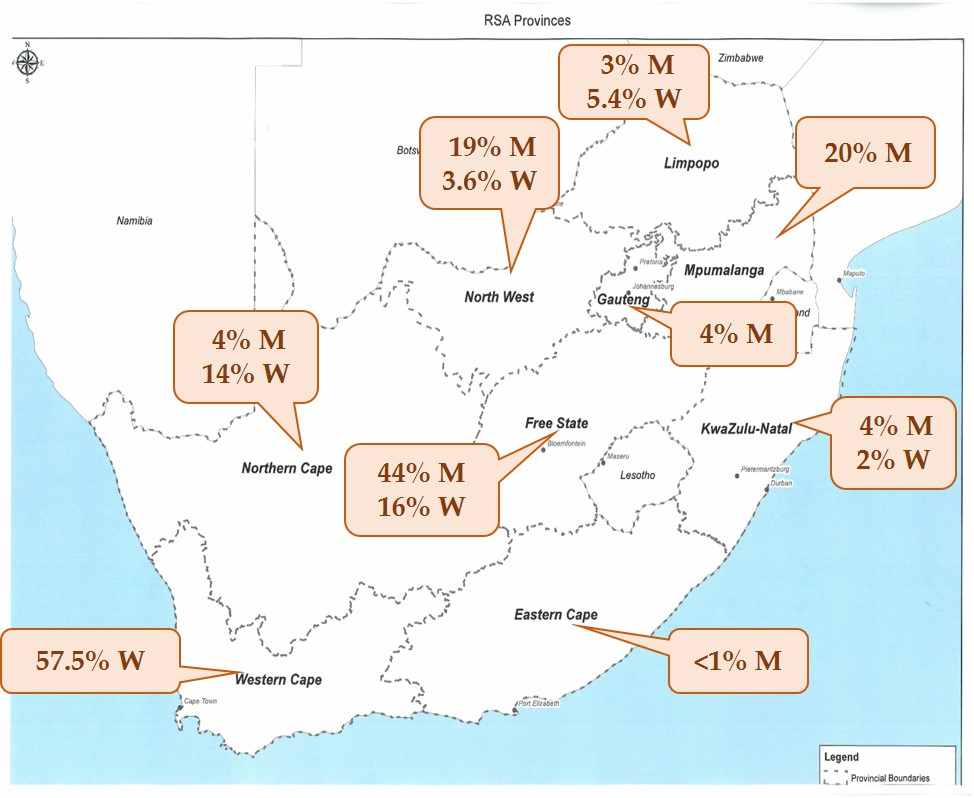

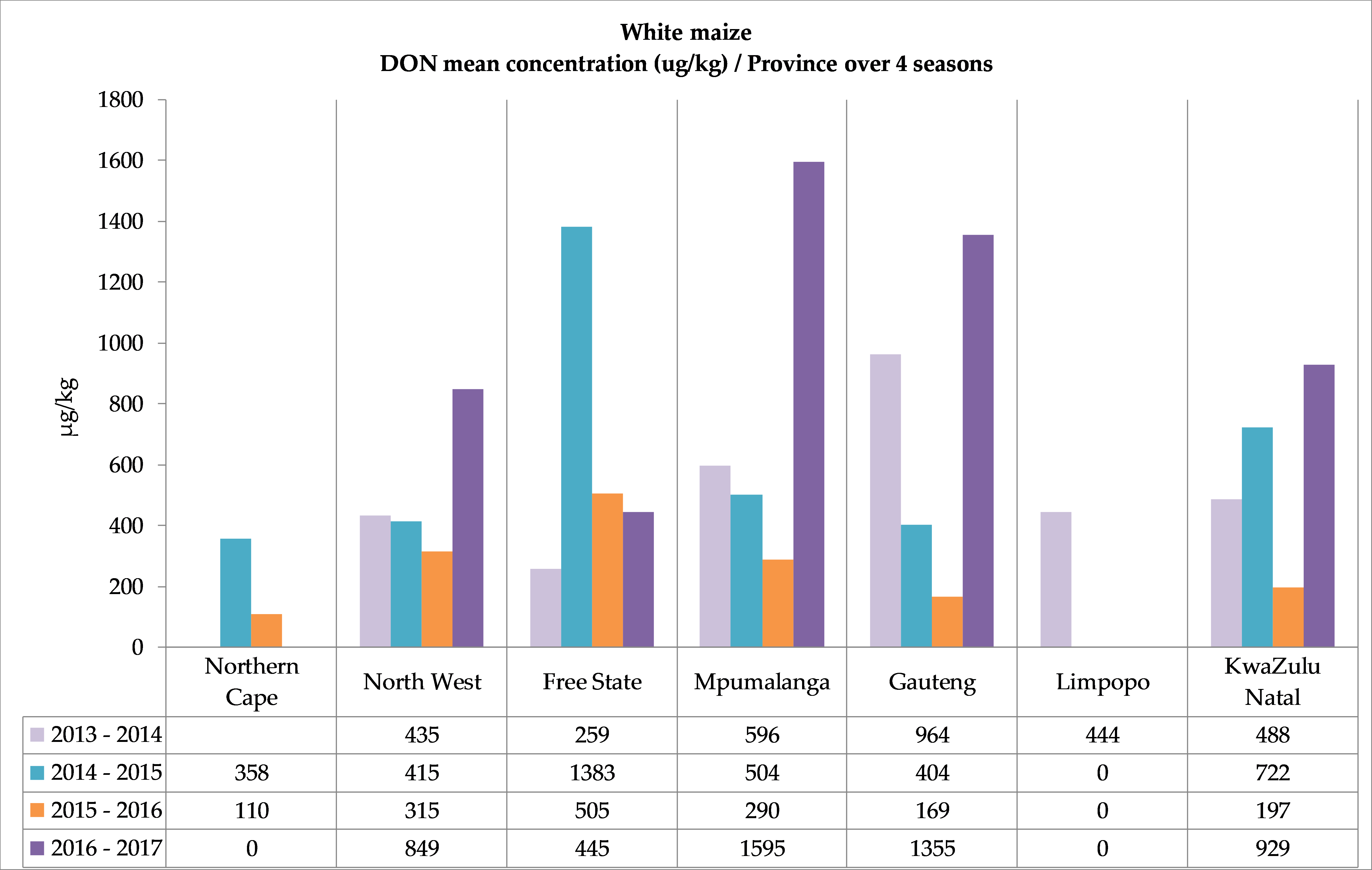
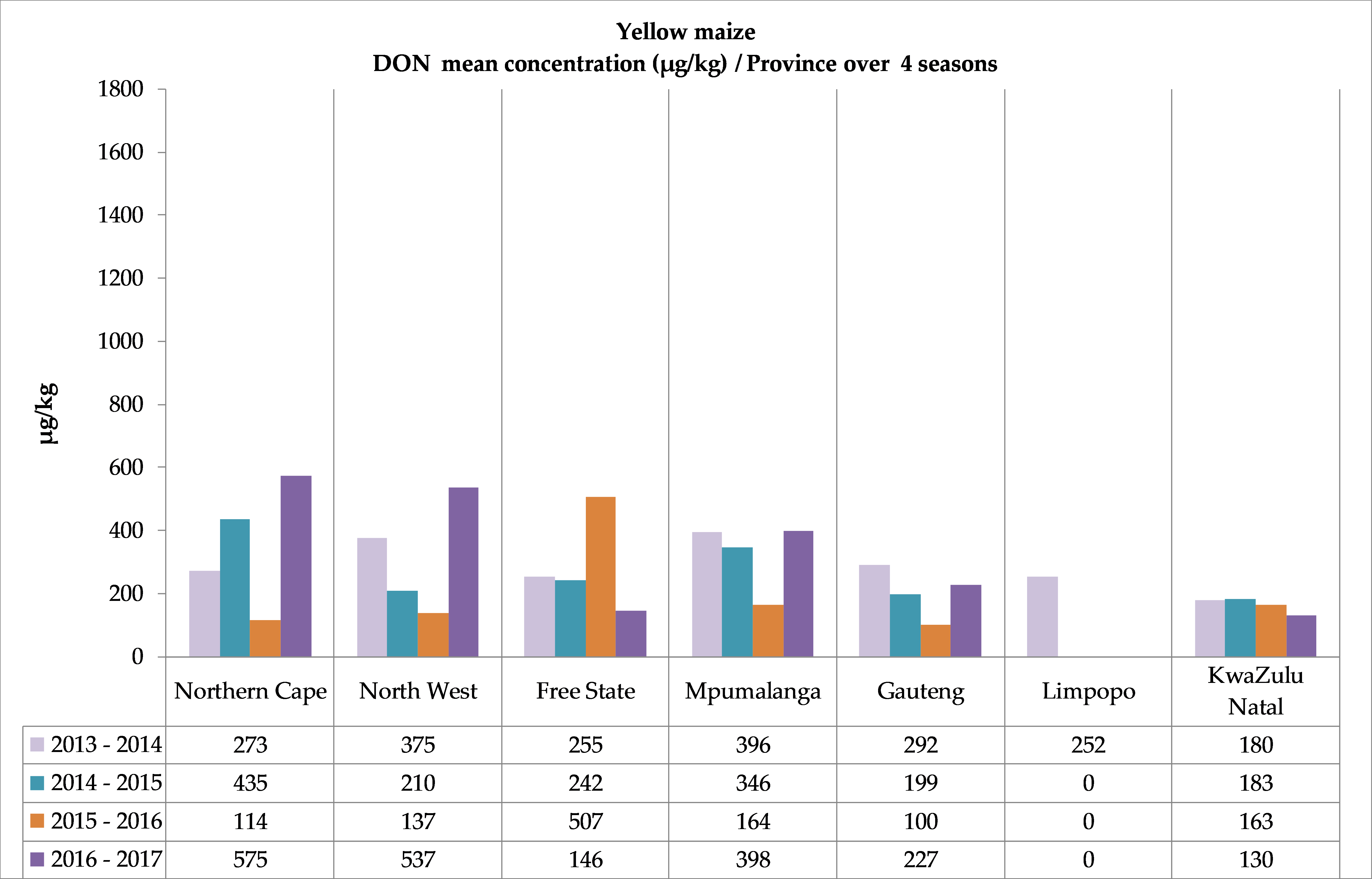

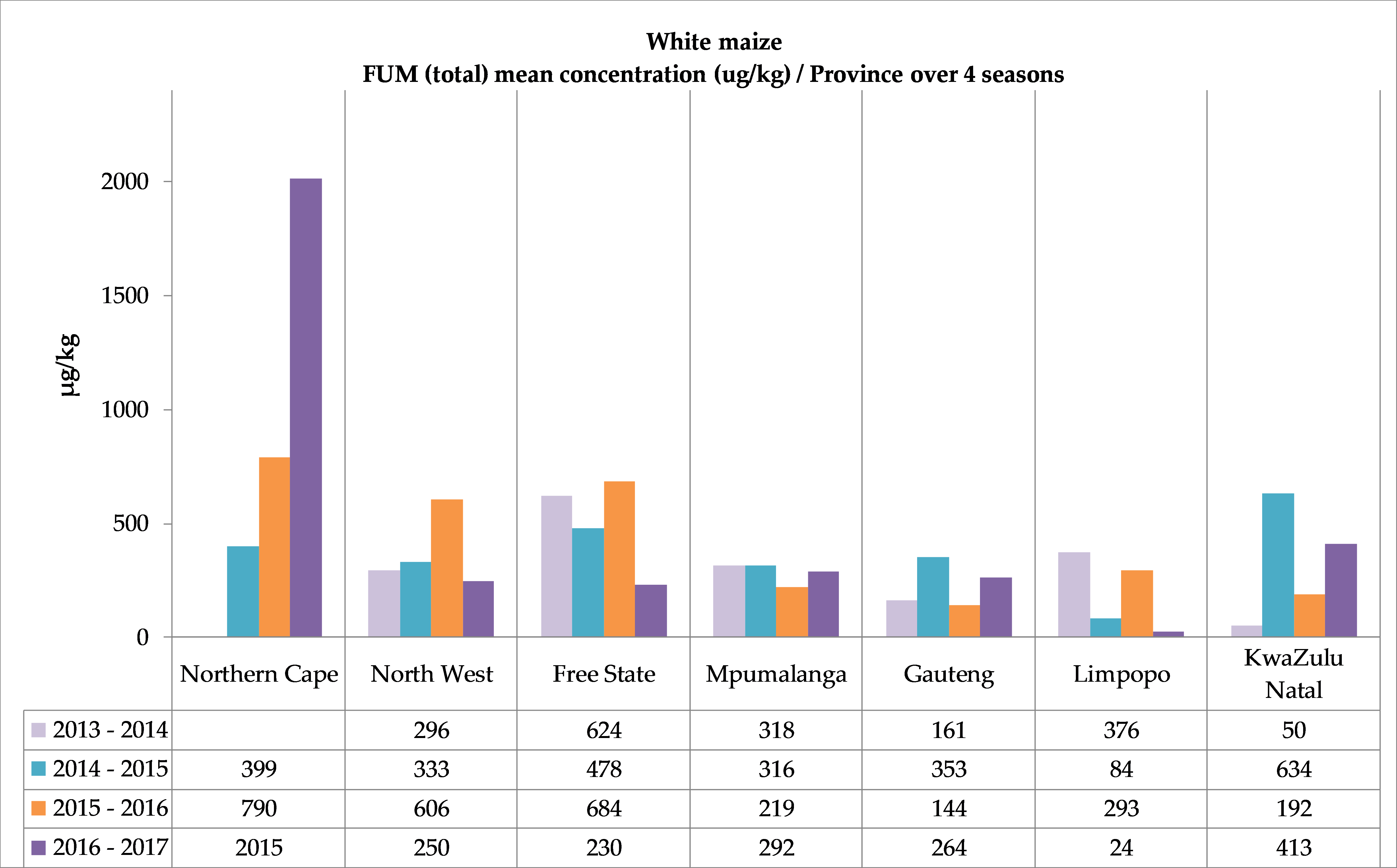
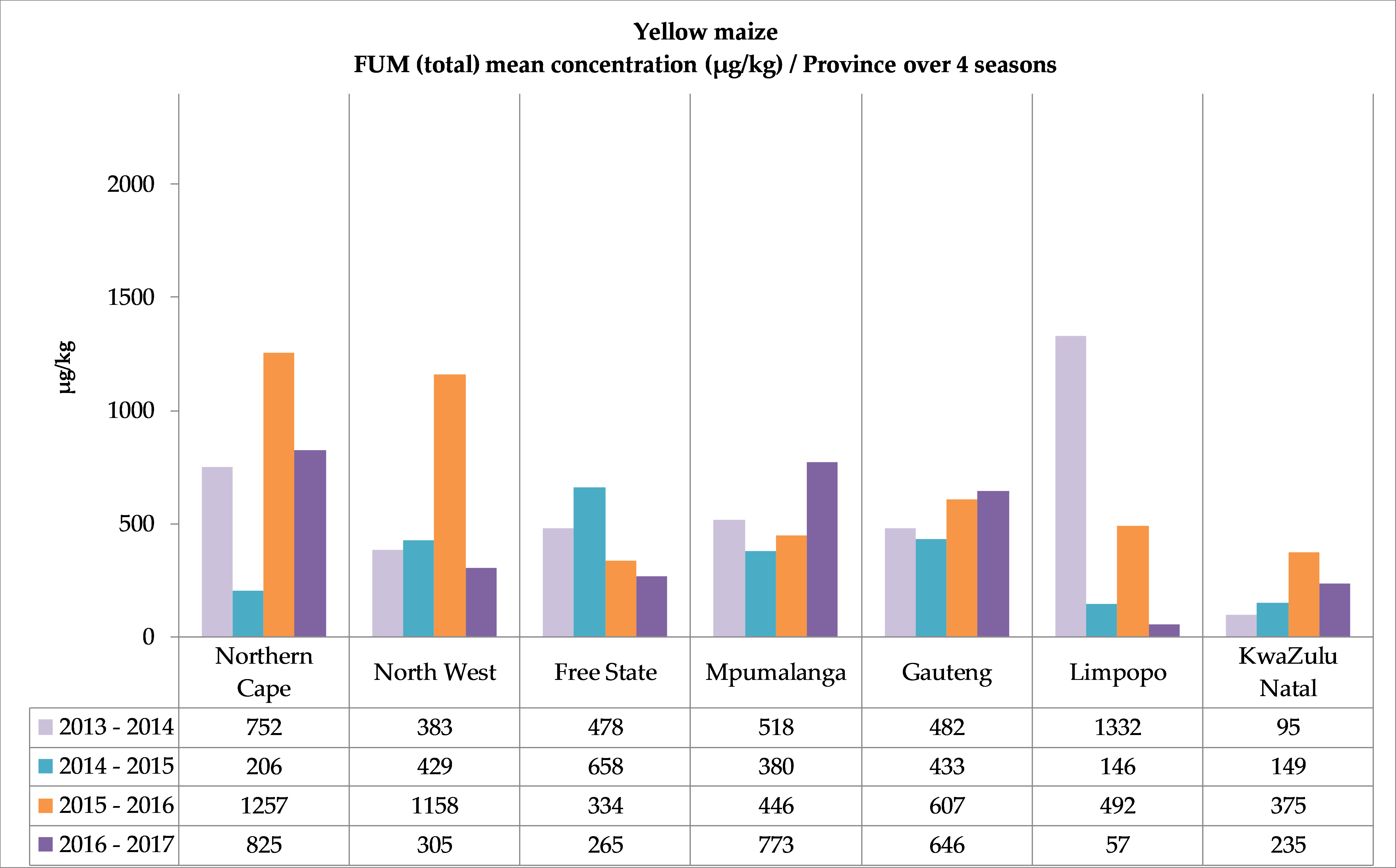
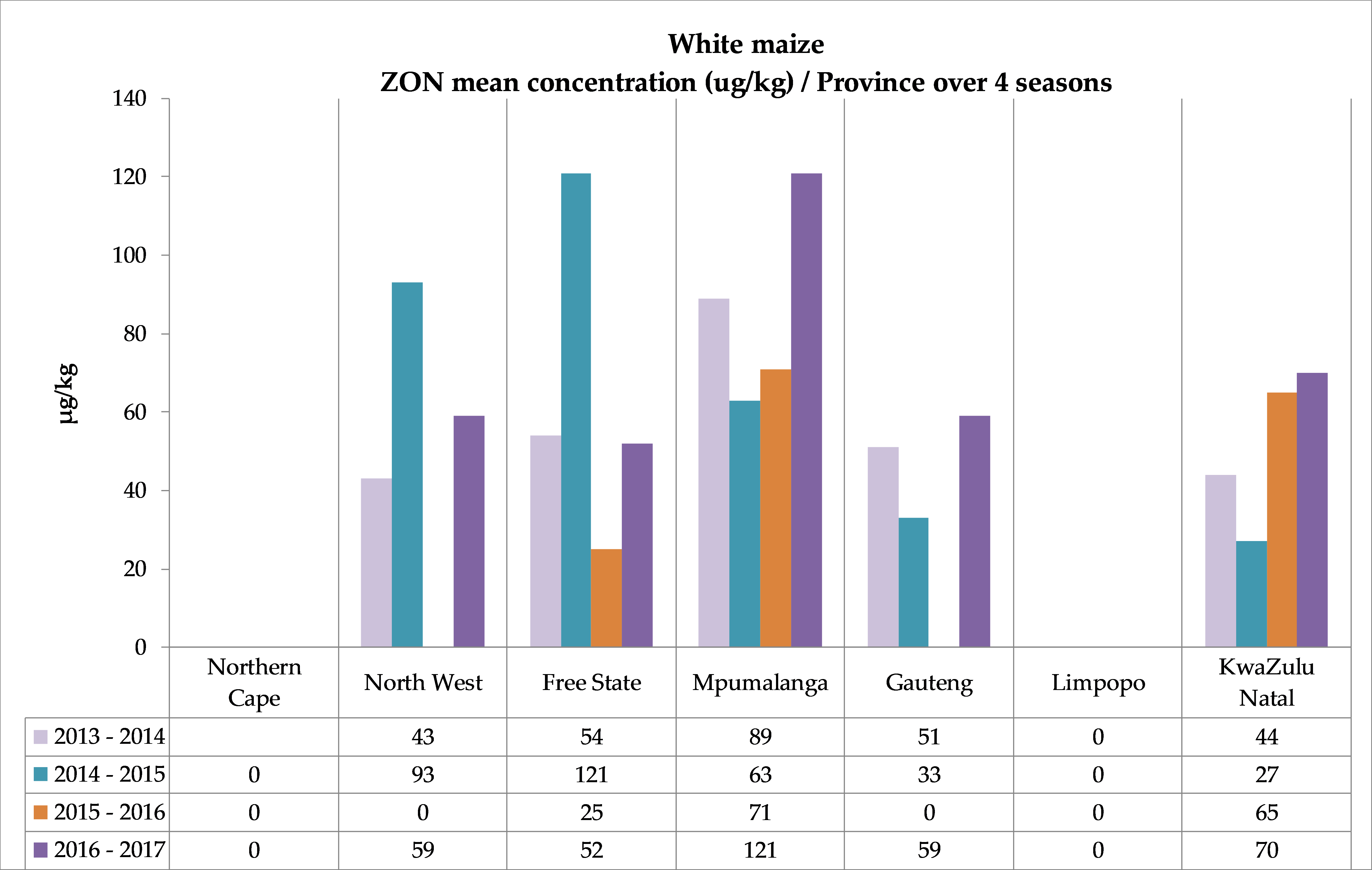
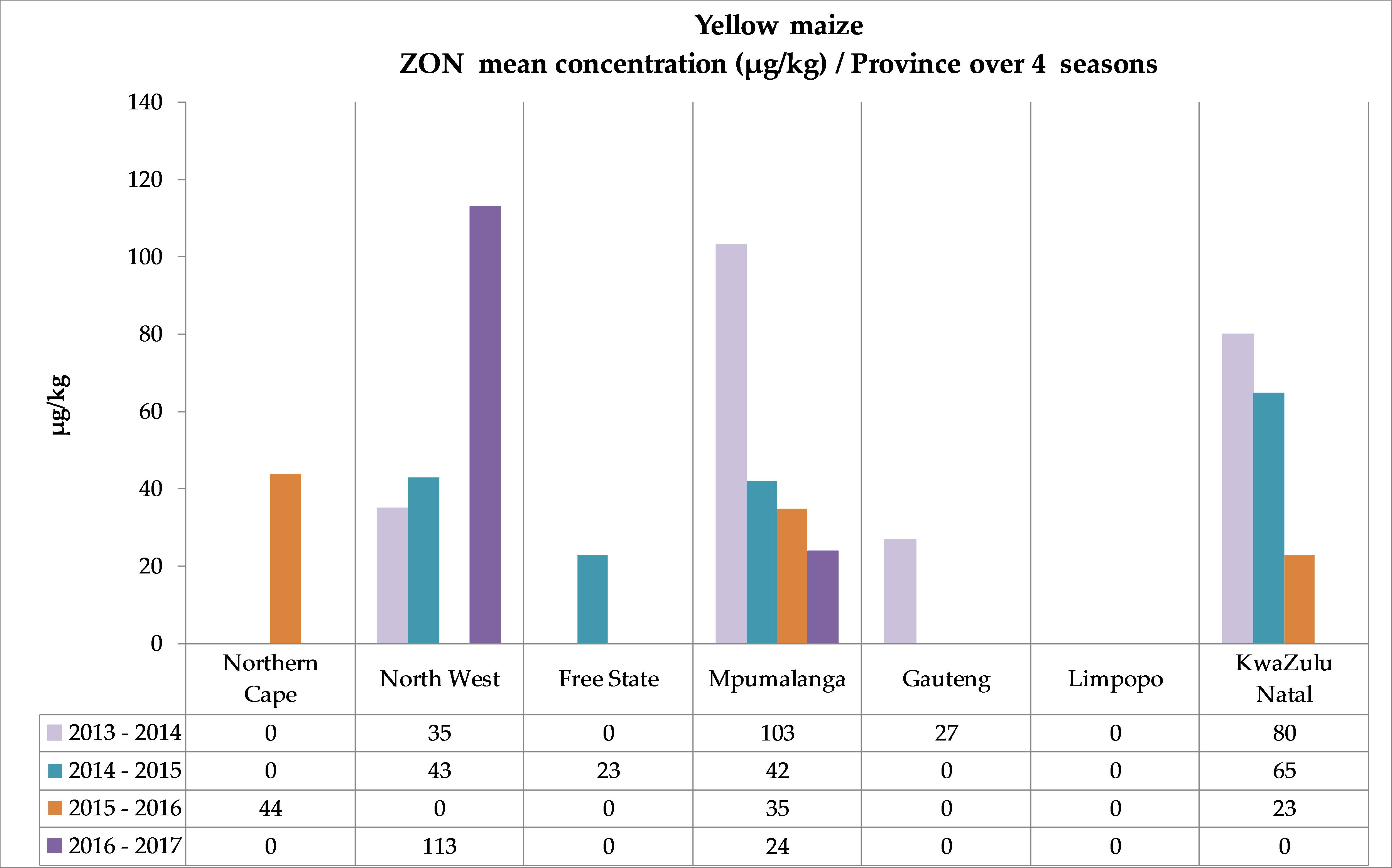
| Production Season | Number of Samples with DON | DON, Mean Concentration 1, µg/kg | DON, Maximum Concentration 2, µg/kg |
|---|---|---|---|
| 2014–2015 | 5/40 | 229 | 361 |
| 2015–2016 | 4/40 | 397 | 593 |
| 2016–2017 | 4/40 | 289 | 501 |
| 2017–2018 | 7/40 | 202 | 570 |
| DON Concentration Range, µg/kg | Percentage Samples with DON | |||||||
|---|---|---|---|---|---|---|---|---|
| White Maize | Yellow Maize | |||||||
| 2013–2014 | 2014–2015 | 2015–2016 | 2016–2017 | 2013–2014 | 2014–2015 | 2015–2016 | 2016–2017 | |
| No deoxynivalenol (<LOQ = 100) | 26.1 | 55.4 | 74.4 | 46.4 | 34.6 | 63.2 | 82.0 | 80.7 |
| 100 < 500 | 55.8 | 31.0 | 21.2 | 28.5 | 55.1 | 34.1 | 17.0 | 13.5 |
| 500–1000 | 10.3 | 7.7 | 3.8 | 7.3 | 8.1 | 2.7 | 1.0 | 3.5 |
| > 1000–2000 | 6.7 | 4.2 | 0.6 | 8.9 | 1.6 | 0.0 | 0.0 | 2.3 |
| > 2000 1 | 1.2 | 1.8 | 0.0 | 8.9 | 0.5 | 0.0 | 0.0 | 0.0 |
| FUM Concentration Range, µg/kg | Percentage Samples with FUM | |||||||
|---|---|---|---|---|---|---|---|---|
| White Maize | Yellow Maize | |||||||
| 2013–2014 | 2014–2015 | 2015–2016 | 2016–2017 | 2013–2014 | 2014–2015 | 2015–2016 | 2016–2017 | |
| No fumonisins (<LOQ = 20) | 56.4 | 42.3 | 38.5 | 55.3 | 61.6 | 45.1 | 46.9 | 56.1 |
| 20 < 750 | 37.6 | 47.6 | 51.9 | 40.8 | 31.9 | 46.2 | 40.2 | 36.3 |
| 750–2000 | 5.5 | 10.1 | 6.4 | 2.8 | 5.4 | 7.1 | 10.3 | 5.3 |
| >2000–4000 | 0.6 | 0.0 | 2.6 | 1.1 | 0.5 | 1.6 | 1.5 | 1.2 |
| > 4000 1 | 0.0 | 0.0 | 0.6 | 0.0 | 0.5 | 0.0 | 1.0 | 1.2 |
| Mycotoxin | Recovery Range, % | Precision, Average RSD, % | Concentration Range of Spiked Samples, µg/kg | Limit of Quantitation (LOQ), µg/kg |
|---|---|---|---|---|
| Aflatoxin B1 | 76–106 | 11.4 | 2–100 | 2 |
| Aflatoxin B2 | 77–108 | 12.8 | 2–100 | 2 |
| Aflatoxin G1 | 79–114 | 12.2 | 2–100 | 2 |
| Aflatoxin G2 | 88–118 | 15.4 | 5–100 | 5 |
| Deoxynivalenol | 80–93 | 13.2 | 100–400 | 100 |
| 15-Acetyl-deoxynivalenol | 76–87 | 17.5 | 100–400 | 100 |
| Fumonisin B1 | 72–94 | 19.6 | 20–400 | 20 |
| Fumonisin B2 | 63–90 | 12.8 | 20–223 | 20 |
| Fumonisin B3 | 68–87 | 13.4 | 20–204 | 20 |
| Ochratoxin A | 76–94 | 13.1 | 2–100 | 2 |
| T2-Toxin | 91–103 | 9.3 | 20–200 | 20 |
| HT-2 toxin | 79–105 | 12.1 | 20–200 | 20 |
| Zearalenone | 72–83 | 13.4 | 20–200 | 20 |
© 2019 by the authors. Licensee MDPI, Basel, Switzerland. This article is an open access article distributed under the terms and conditions of the Creative Commons Attribution (CC BY) license (http://creativecommons.org/licenses/by/4.0/).
Share and Cite
Meyer, H.; Skhosana, Z.D.; Motlanthe, M.; Louw, W.; Rohwer, E. Long Term Monitoring (2014–2018) of Multi-Mycotoxins in South African Commercial Maize and Wheat with a Locally Developed and Validated LC-MS/MS Method. Toxins 2019, 11, 271. https://0-doi-org.brum.beds.ac.uk/10.3390/toxins11050271
Meyer H, Skhosana ZD, Motlanthe M, Louw W, Rohwer E. Long Term Monitoring (2014–2018) of Multi-Mycotoxins in South African Commercial Maize and Wheat with a Locally Developed and Validated LC-MS/MS Method. Toxins. 2019; 11(5):271. https://0-doi-org.brum.beds.ac.uk/10.3390/toxins11050271
Chicago/Turabian StyleMeyer, Hannalien, Zanele Diana Skhosana, Mamsy Motlanthe, Wiana Louw, and Egmont Rohwer. 2019. "Long Term Monitoring (2014–2018) of Multi-Mycotoxins in South African Commercial Maize and Wheat with a Locally Developed and Validated LC-MS/MS Method" Toxins 11, no. 5: 271. https://0-doi-org.brum.beds.ac.uk/10.3390/toxins11050271




